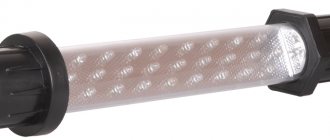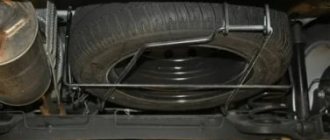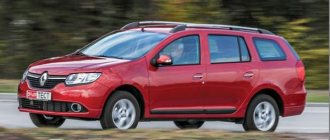All about the trunk of the Lada Largus - volume, dimensions, features
LADA Largus has long won the sympathy of Russian car enthusiasts. Drivers often pay attention to the large trunk volume of the Lada Largus, which is considered the main advantage of this car. Domestic cars also cope well with another task - providing inexpensive and comfortable travel on modern roads. These two aspects and the ability to accommodate a large number of passengers allowed the car, produced at the Russian AvtoVAZ, to become a popular model in the CIS countries.
The dimensions of the Largus trunk depend on the body variation, it can be:
Each car variation has its own luggage compartment volume. In a station wagon designed for 5 seats, the volume of this compartment is 700 liters. But the owner of this model can transport a large load. In the Lada Largus station wagon, the trunk volume can be increased to 1500–1800 liters by removing the second row of seats - a three-seater sofa. With the seats folded down, the station wagon's luggage compartment volume increases to 2,350 liters.
The Largus van has the largest trunk dimensions. In this variation of the car there is no back row of seats, and sometimes even two, and the body is elongated. Officially, the van's trunk capacity is 2,500 liters. The main task of the model is to transport goods, so there are no additional components or elements inside the body.
The van has a reinforced suspension, as this model is designed for transporting large cargo. Station wagons do not have this option.
Lada Largus - possible competitors
Lada Largus has practically no competitors in its price category.
Today in our review we will talk about the technical characteristics of the Lada Largus, price, photos, videos and all the current trim levels of the Lada Largus in Russia.
New Lada Largus
nothing more than a Renault Logan in a universal body. In a similar body, Renault is produced in Romania at the Dacia plant and is called Dacia Logan MCV (Dacia Logan MCV). Accordingly, there is little difference, if only in name. However, the Dacia Logan Pick-Up two-door heel is also produced in Romania. There is also an all-metal double cargo version of the Dacia Logan Van, which is also produced at AvtoVAZ under the familiar name Lada Largus.
I would like to note that in 2013, Logan MSV in a new body began to be produced in Romania. The basis was the same Logan, which underwent a major update. Soon Sandero and Logan MCV were updated. However, the update has not yet reached Russia. If Logan and Sandero in a new body will most likely appear in 2014, then it is unknown when the Lada Largus will be updated. Although, why update a car that is successfully selling. alone, 57,641 new Largus were sold in Russia
. Moreover, demand is only growing. Why a new body for Largus when the old car sells well. Over the past year, the car entered the top 10 best-selling cars in Russia. I would like to believe that the introduction of the new body at AvtoVAZ will not be delayed.
Lada Largus is available in 5 and 7 seat versions
, plus an all-metal van body for freight transport. The difference between the regular Logan and Largus is the increased wheelbase, which is 2,905 mm, while the Logan has only 2,630 mm. As a result, the station wagon's interior has become much larger, by almost 30 centimeters. It was possible to fit even the third row of seats in the Lada Largus 7-seat version. The 5-seater version of the Lada Largus with a 700-liter luggage compartment boasts a useful volume of 2,350 liters with the seats folded down! In other characteristics, Largus is very close to Logan. You can see this in the photo of Largus in our article.
Engine in the domestic Lada Largus
costs naturally from Renault. These are two gasoline engines of different power, but the same displacement, which is 1.6 liters. The difference in power is determined by the presence of 8 or 16 valves, these are 84 and 105 horsepower, respectively. The transmission is front-wheel drive, there is only one transmission, it is a 5-speed manual gearbox. Largus safety is ensured by the latest generation ABS and three-point seat belts. Frontal airbags are also provided for the driver and front passenger. More details about the technical specifications below.
Dimensions of Lada Largus
- Length – 4,470 mm
- Width – 1,750 mm
- Height – 1,636 mm (with rails 1,670)
- Wheelbase, distance between front and rear axle – 2,905 mm
- Front and rear wheel tracks – 1469 and 1466 mm, respectively
- Trunk volume – 560 liters (in the 7-seater version 135 liters, in the van 2,540 liters!)
- Fuel tank size – 50 liters
- Ground clearance or ground clearance of Lada Largus – 160 mm
- Weight in 5-seater version 1,260 kg - total 1,750
- Weight in 7-seater version 1,330 kg - total 1,810
- Weight in the Largus van version 1,260 kg - total 2,010
- The carrying capacity of the Lada Largus van is 750 kilograms
Engine Lada Largus 1.6 liter 8-valve 84 hp.
- Power hp/kW – 84/62 at 5500 rpm
- Torque – 124 Nm at 3000 rpm
- Maximum speed – 156 kilometers per hour
- Acceleration to the first hundred – 14.5 seconds
- Fuel consumption in the combined cycle – 8.2 liters
Engine version 1.6 liter 16-valve 105 hp.
- Power hp/kW – 105/77 at 5750 rpm
- Torque – 147 Nm at 3750 rpm
- Maximum speed – 165 kilometers per hour
- Acceleration to the first hundred – 13.1 seconds
- Fuel consumption in the combined cycle – 7.9 liters
Salon Largus
not much different from the Renault Logan, if only in the color of the seat upholstery.
The car is available in three trim levels – Standard, Normal, Luxury. An automatic transmission for the Lada Largus
is not yet available, but air conditioning can be ordered.
All trim levels have audio preparation! The car creates a pleasant impression. A real budget station wagon for a large family. We bring to your attention a photo of the Largus salon
. Both the interior and exterior are pleasant. Now we will tell you in detail about the trim levels and prices for the Lada Largus in 2014.
Equipment Lada Largus Standard 5 seats
the price of the station wagon is 369,000 rubles. The car has an 8 valve engine with a volume of 1.6 liters (84 hp) and a 5-speed manual transmission.
- Airbag for the driver Head restraints for the rear seats ISOFIX mounts Mechanical headlight leveling Locking the door locks against accidental opening by children The steering column is tilt adjustable There is audio preparation 15-inch steel wheels Full-size spare tire
No air conditioning
in this version.
Equipment Lada Largus Standard 5 seats
the price of the station wagon is 393,000 rubles. The station wagon has an 8-valve engine with a volume of 1.6 liters (84 hp) and a 5-speed manual transmission.
The following options are added −
- ABS brakes Split second row seat Power steering appears Central locking Power front windows
Equipment Lada Largus Lux 5 seats
, but with a 16 valve engine producing 105 horses. The price starts at 441,700 rubles.
The following options appear −
- Air conditioning Another front airbag for the passenger Roof rails Central locking with remote control Heated seats Power windows on all doors Audio system with Hands free and radio
Equipment Lada Largus Standard 7 seats
offered from 443,500 rubles. The only power unit is an 8-valve 84 hp engine.
- Air conditioning Two front airbags ABS system Power steering and tilt steering Audio system Front electric windows and bumpers painted in body color Stamped steel wheels 15 inches
Equipment Lada Largus Lux 7 seats
has a price starting from 463,700 rubles. The only power unit is a 16-valve 105 hp engine. The following options are added −
- Fog lights On-board computer Luggage rack in the roof Driver's seat with height adjustment Audio system with 4 speakers, normally there are only 2 Plus all the windows and other little things 15-inch alloy wheels
Configurations of Lada Largus Van
are offered only in Standard and Norma versions at prices from 339,000 to 387,000 rubles, respectively. They offer customers only an 8-valve 1.6-liter engine. The more expensive version has power steering and air conditioning.
Lada Largus crash test video
.
Video test drive Lada Largus
.
Here's another entertaining video, Largus off-road
!
In general, it is excellent, one might say unique, since the car simply has no analogues. Thanks to the French for the first affordable station wagon with three rows of seats on the domestic car market. Actually, there is nothing to compare this car with; all competitors of the Lada Largus have a price that is two or even three times higher.
For most car enthusiasts who have chosen the Lada Largus as their faithful road companion, practicality is usually a priority, and trunk volume plays an important role. Behind it are two global concepts related to providing such convenient options as:
- achieving comfortable movement when loaded on roads with different surfaces;
- getting a car that can surprise you with its carrying capacity and spaciousness of the luggage compartment.
In practice, many owners have verified that the Lada Largus fully complies with these two aspects. This allowed the universal “Russian” to capture the “hearts” of car enthusiasts not only in the domestic space, but also to prove itself in the market of the CIS member countries, because the trunk size is quite acceptable, and the car also has 5 seats.
In our material, we intend to highlight the features of the luggage compartment of this model in comparison with classmates, who are also competitors, and we will also clarify the size of the luggage compartment.
Cross
The smallest trunk size is in the Largus minivan, designed for 7 seats. The Largus Cross trunk reaches a volume of 200 liters. The manufacturer helped car owners by allowing them to increase the volume of the luggage compartment in liters to 1600–1800, for which two rows of seats should be removed.
The seven-seater version (minivan) has the most “modest” luggage compartment. But the manufacturer met his loyal customer halfway and endowed this modification with a simple secret: it is also possible to increase the luggage space to the same 1600–1800 liters by performing an identical operation to dismantle the stern seats. To do this, you will need to remove two planting rows.
Of course, neither a station wagon nor a minivan are designed to transport large loads, but if necessary, they will cope with this task perfectly.
dimensions and dimensions in centimeters, length, width
LADA Largus has long won the sympathy of Russian car enthusiasts. Drivers often pay attention to the large trunk volume of the Lada Largus, which is considered the main advantage of this car. Domestic cars also cope well with another task - providing inexpensive and comfortable travel on modern roads. These two aspects and the ability to accommodate a large number of passengers allowed the car, produced at the Russian AvtoVAZ, to become a popular model in the CIS countries.
The dimensions of the Largus trunk depend on the body variation, it can be:
Each car variation has its own luggage compartment volume. In a station wagon designed for 5 seats, the volume of this compartment is 700 liters. But the owner of this model can transport a large load. In the Lada Largus station wagon, the trunk volume can be increased to 1500–1800 liters by removing the second row of seats - a three-seater sofa. With the seats folded down, the station wagon's luggage compartment volume increases to 2,350 liters.
The Largus van has the largest trunk dimensions. In this variation of the car there is no back row of seats, and sometimes even two, and the body is elongated. Officially, the van's trunk capacity is 2,500 liters. The main task of the model is to transport goods, so there are no additional components or elements inside the body.
The van has a reinforced suspension, as this model is designed for transporting large cargo. Station wagons do not have this option.
Cross
The smallest trunk size is in the Largus minivan, designed for 7 seats. The Largus Cross trunk reaches a volume of 200 liters. The manufacturer helped car owners by allowing them to increase the volume of the luggage compartment in liters to 1600–1800, for which two rows of seats should be removed.
The seven-seater version (minivan) has the most “modest” luggage compartment. But the manufacturer met his loyal customer halfway and endowed this modification with a simple secret: it is also possible to increase the luggage space to the same 1600–1800 liters by performing an identical operation to dismantle the stern seats. To do this, you will need to remove two planting rows.
Of course, neither a station wagon nor a minivan are designed to transport large loads, but if necessary, they will cope with this task perfectly.
Luggage compartment dimensions
Based on the above, we can conclude that the dimensions of the luggage compartment of any version of the Lada Largus are quite impressive. The general dimensions of this compartment for the models are as follows:
- opening height is 920 mm;
- the opening width is 980 mm;
- the height of the luggage compartment to the ceiling is from 870 to 930 mm for universal models and up to 1000 mm for a van;
- trunk length is 480–1570 mm for station wagons up to the 3rd and 2nd row of seats;
- The length of the van's luggage compartment is 1800 mm to the dividing wall;
- luggage compartment width – 1000–1450 mm.
Advantages and disadvantages
To make the right decision, you need to study not only the advantages, but also the disadvantages of the model. The owners, who have extensive experience in operating Largus, found one drawback. The car manufacturer did not adjust the interior of the station wagons in such a way that their owners would have the opportunity to transport large loads. If the driver nevertheless decided to load a large object into his car, then the cargo often caused damage to the interior.
Otherwise, Lada Largus owners are satisfied with everything in their cars. Among the advantages of a Russian car are the following:
- ease of loading;
- optimal dimensions;
- the ability to increase trunk capacity by removing the seats;
- high load capacity;
- possibility of modernization.
Drivers universally note the practicality and convenience of the LADA Largus trunk. Its size is quite enough to demonstrate the functionality of a domestic car, which allowed it to become a leader among its closest competitors. The manufacturer managed to competently and rationally approach the arrangement of the body space, which allows Largus to successfully transport large objects and indicates the enviable carrying capacity of the model.
Lada Largus is recommended for those drivers who want to get a car with the best consumer properties and technical characteristics.
Luggage compartment dimensions
Based on the above, we can conclude that the dimensions of the luggage compartment of any version of the Lada Largus are quite impressive. The general dimensions of this compartment for the models are as follows:
- opening height is 920 mm;
- the opening width is 980 mm;
- the height of the luggage compartment to the ceiling is from 870 to 930 mm for universal models and up to 1000 mm for a van;
- trunk length is 480–1570 mm for station wagons up to the 3rd and 2nd row of seats;
- The length of the van's luggage compartment is 1800 mm to the dividing wall;
- luggage compartment width – 1000–1450 mm.
Advantages and disadvantages
To make the right decision, you need to study not only the advantages, but also the disadvantages of the model. The owners, who have extensive experience in operating Largus, found one drawback. The car manufacturer did not adjust the interior of the station wagons in such a way that their owners would have the opportunity to transport large loads. If the driver nevertheless decided to load a large object into his car, then the cargo often caused damage to the interior.
Otherwise, Lada Largus owners are satisfied with everything in their cars. Among the advantages of a Russian car are the following:
- ease of loading;
- optimal dimensions;
- the ability to increase trunk capacity by removing the seats;
- high load capacity;
- possibility of modernization.
Drivers universally note the practicality and convenience of the LADA Largus trunk. Its size is quite enough to demonstrate the functionality of a domestic car, which allowed it to become a leader among its closest competitors. The manufacturer managed to competently and rationally approach the arrangement of the body space, which allows Largus to successfully transport large objects and indicates the enviable carrying capacity of the model.
Dimensions of LADA Largus: size of tires, body, wiper blades
When purchasing a particular vehicle, a person always adheres to certain goals. In the case of purchasing a Lada-Largus, as a rule, motorists want to get a roomy and easy-to-use car.
While this model has proven itself in terms of convenience, there is not much information about its dimensions. In today’s material, our resource decided to take a closer look at the dimensions of different components of the Lada-Largus and, in general, the overall dimensions of the car. At the same time, we focus attention not only on technical information, but also on reviews from model owners. Well, let's get started.
see also
Comments 54
Please tell me, is the length of the compartment at the top much shorter than at the bottom? Does this protrusion under the backrests steal a lot? Is there about a meter and a half left?
Back about 20cm
If I buy Largus, I’ll call it BOAT! This is such an interesting car, I like it, it’s simple like a Japanese one and not whimsical like a European one, but high-torque like an American one! In general, only Kandy from Volkswagen is cooler, but very expensive.
The length at the bottom is 187cm, how can the sofa fit there? I recently transported a locker for a 5-seater, the height of the cabinet (the wall in the nursery) is 200 cm, I folded the boards in bundles of short ones to the level of the front seats, and 200 cm for the backs of the seats. Only the swing was large, the boards lay in a narrow stack.
Fret length Largus station wagon
The body dimensions of the Lada Largus are impressive; they can be called the largest among the B-class representatives. Currently, this car is available in three versions: a passenger station wagon (5 seats), a high-capacity station wagon (7 seats) and a cargo van. In this review we will talk about the dimensions of the Lada Largus.
The dimensions of the Lada Largus station wagon and van are the same, except for the height.
Station wagon (R90)
| Van (F90) | ||
| Length, mm | 4470 | |
| Width, mm | 1750 | |
| Width with mirrors, mm | 2003 | |
| Height, mm | 1636 | 1650 |
| Height with rails, mm | 1670 | 1686 |
| Wheelbase, mm | 2900 | |
| Front wheel track, mm | 1469 | |
| Rear wheel track, mm | 1466 | |
We have already said more than once that the Lada Largus is a 2006 Dacia Logan MCV adapted for the Russian market, so the remaining dimensions can be borrowed from its progenitor:
The length of the cabin from the trunk door to the windshield in the area of the dashboard is 3 m. 14 cm . Distance from tailgate to dashboard
2 m. 70 cm . The diagonal size of the cabin (from corner to corner) is 3 m. 24 cm . The width of the cabin behind the front seats is 1 m 43 cm. The width of the cabin at the shoulder level of the third row passengers is about 1 m 29 cm . Distance from the tailgate threshold to the folded rear seat of the second row (it stands upright)
1.5 m (max 1.66 m) With the rear seat completely removed, the distance will increase by another 20 cm .
To transport long items, fold down the backrest of the second row and recline the backrest of the front passenger seat onto it. An extra-long weight can be rested with one end on the instrument panel, just be sure to place something soft so as not to scratch the plastic. And secure the length with a seat belt.
Lada Largus - advantages
Lada Largus is a very spacious and roomy car. It is affordable, does not have the highest price, but is very affordable and quite functional. First of all, it is one of the most affordable in its class. Secondly, it was created for an urban environment, and the presence of an off-road version allows it to be used in the suburbs, as well as on light off-road conditions.
From a technical point of view, the car is also good. With the older engine, good dynamics are obtained. The suspension and long wheelbase provide good road stability and energy efficiency on poor road surfaces.
Lada Largus 5 Technical characteristics
Characteristics
Engines for Largus are 1.6-liter gasoline. Their power is low: the eight-valve unit has 87 hp. at 5100 rpm (140 Nm), and for a sixteen-valve engine - 106 hp. at 5800 rpm (148 Nm). But both absolutely easily “digest” inexpensive 92-octane gasoline, which is, of course, very important in Russian realities. According to the manufacturer, average fuel consumption ranges from 7.9 to 8.2 liters. per 100 km, which, judging by numerous test drives and reviews from car owners, is practically no different from the truth. Any of the engines is combined with a non-alternative five-speed manual transmission, and there are no modifications with automatic transmission yet. As well as a diesel engine with all-wheel drive, but a more economical diesel version would obviously not hurt, not to mention all-wheel drive coupled with an increased ground clearance of 2-3 cm.
Dimensions
- length - 4.470 m;
- width - 1,750 m;
- height - 1.636 m;
- wheelbase - 2.9 m;
- ground clearance - 145 mm;
- trunk volume - 560 l.
Technical characteristics of Largus van. Lada Largus van body length
Dimensions of the Lada Largus 2018 van
Dimensions of the Lada Largus van
Russian sales of Lada Largus began in July 2012. The car is available in 7- and 5-seater versions, as well as in a van body.
The car has the following technical characteristics: 8 and 16 valve petrol engine with a volume of 1.6 liters and a power of 87 hp. and 106 hp
The Lada Largus 2020 van has dimensions: 4470 mm in length, 1750 mm in width and 1650 mm in height. The volume of the luggage compartment is 2540 liters.
Dimensions
Video
New video review and test drive of the van:
Fuel consumption
The station wagon consumes only about 8.1 liters per 100 km in the combined cycle
Tire sizes are 185/70R14, 185/65R15.
See vehicle specifications and prices here.
Specifications
| Characteristics | 1.6MT | 1.6MT |
| Engine's type: | Petrol | Petrol |
| Engine capacity: | 1598 | 1598 |
| Power: | 106 hp | 87 hp |
| Acceleration to 100 km/h: | 13.1 s | 14.5 s |
| Maximum speed: | 165 km/h | 156 km/h |
| Consumption in the urban cycle: | 11.5/100km | 12.3/100km |
| Extra-urban consumption: | 7.5/100km | 7.5/100km |
| Combined cycle consumption: | 9.0/100km | 9.3/100km |
| Fuel tank capacity: | 50 l | 50 l |
| Length: | 4470 mm | 4470 mm |
| Width: | 1750 mm | 1750 mm |
| Height: | 1636 mm | 1636 mm |
| Wheelbase: | 2906 mm | 2906 mm |
| Clearance: | 145 mm | 145 mm |
| Weight: | 1260 kg | 1260 kg |
| Trunk volume: | 560 l | 560 l |
| Transmission: | Mechanical | Mechanical |
| Drive unit: | Front | Front |
| Front suspension: | Independent – McPherson | Independent – McPherson |
| Rear suspension: | Semi-independent - torsion beam | Semi-independent - torsion beam |
| Front brakes: | Disk | Disk |
| Rear brakes: | Drums | Drums |
| Production: | Tolyatti | |
| Guarantee: | 3 years or 100,000 km |
Take advantage of the opportunity to save up to 70,000 rubles on your purchase by trading in your old car under the exchange program.
Article rating:
Dimensions of Lada Largus station wagon Link to main publication
Related publications
- Turn signals in mirrors of VAZ 2114
Suspension, brake and steering mechanisms of Largus
The front suspension of the car is MacPherson type with anti-roll bar, and the rear is an H-shaped beam with trailing arms. High energy intensity and long wheel travel have long been the hallmark of models built on the B0 platform; they don’t care about any potholes. In addition, roll and pitch are at an acceptable level here. Especially for high-load operation, these machines are equipped with reinforced springs.
Of the entire suspension, the ball joints have the least service life. When out of order, they give themselves away by constant tapping while moving. They wear out especially quickly in cars that constantly drive at or exceed the maximum permissible load. CV joint boots often break here. If you do not notice this, then soon you will hear a crunching sound when turning the steering wheel and you can slowly prepare to replace one or another entire drive.
The front brakes are ventilated disc, rear drum. They have mediocre efficiency, but are quite predictable. Previously, the ABS system was an option, but now it is installed on absolutely all of our new cars, without exception. Due to their excessive rigidity, original brake pads quickly render the discs unusable and they are often replaced together. High-quality analogues increase the service life of brake discs by at least twice.
The steering is quite heavy here, but with good feedback. The station wagon takes turns well, even at very high speeds. In addition, the steering rack rarely begins to knock or play to the point of extreme mileage. A leaking power steering is considered a regularly occurring problem, but it can be solved simply and very inexpensively.











